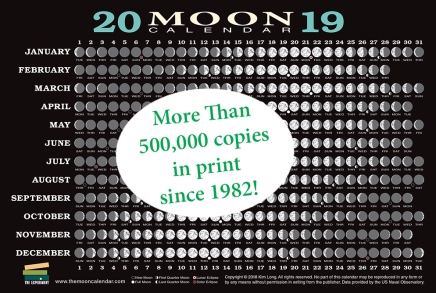July 24, 2019
Last Quarter Moon
8:18 pm EST; 7:18 pm CST; 6:18 pm MST; 5:18 pm PST. Occurs following day: 118 am UT.
Moon’s age: 22 days 0 hours (at noon EST)
Fraction of the Moon illuminated: 58 percent (midnight EST) 54 percent (noon EST)
On this day in 1751, French explorer Antoine de la Mothe Cadillac founded the settlement of Fort Pontchartrain in the territory of Michigan. It was later renamed Detroit.
On this day in 1969, the first three astronauts to make it to the surface of the Moon returned to Earth. The Apollo 11 capsule, carrying Neil Armstrong, Buzz Aldrin, and Michael Collins, splashed down in the Pacific about 950 miles southwest of Honolulu.
________________________________________________________________________________
Times. Time of day is indicated as UT (Universal Time), EST (Eastern Standard Time), CST (Central Standard Time), MST (Mountain Standard Time), and PST (Pacific Standard Time). To figure Daylight Saving Time when in effect locally, subtract one hour from the time indicated for a U.S. time zone. Because of the time difference between UT and North America, at the time of a full moon or other moon phase, the date may fall a day earlier in the United States (indicated when this occurs).
Fraction of the Moon illuminated. The percentage of the front (visible) side of the moon that is lit by sunlight, with 0 percent indicating a new moon (not visible) and 100 percent indicating a full moon (no shadow visible); quarter moons are 50 percent illuminated. Below 5 percent illumination, when the lit portion is a slim crescent (on the left side for a waning moon – “old crescent moon” and on the right side for a waxing moon – “new crescent moon”) it may not be visible in most locations. The percentage is computed by the Astronomical Applications Department/U.S. Naval Observatory. In the course of a 24 hour period, the percentage will either increase or decrease at a varying rate depending on the phase, with the slowest visible change occurring around the time of the full moon and the fastest visible change occurring around the time of the new moon. This is due to the effect of light from the sun illuminating the spherical surface of the Moon.
Moon’s age. One complete lunation (a complete cycle from one new moon to the next new moon) occurs in an average of 29.5 days. The “moon’s age” is the number of calendar days from the time of the new moon, shown here with the number of hours depicted as a rounded number. The figure listed is for noon, EST.
© Copyright 2011, 2012, 2013, 2014, 2015, 2016, 2017, 2018, 2019 Kim Long.


![The Moon Almanac 2019 by [Long, Kim]](https://images-na.ssl-images-amazon.com/images/I/51MbHaDLsIL.jpg)

Leave a comment